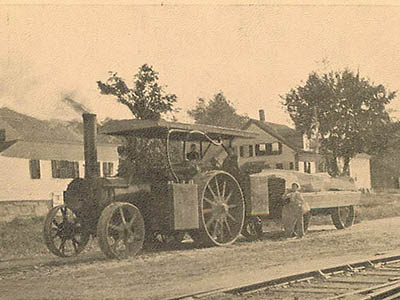History Of Buisness and Industry in Fitzwilliam

The Granite Industry
The Granite industry was the most important business in Fitzwilliam for more than fifty years, and for a long time it was one of the three principal granite centers of the state. Before any quarries were opened, it had been found that large sheets of stone, which required no dressing except to free them at the sides and ends, could be taken from the surface of the hill south of Fitzwilliam Depot. They were freely utilized. The porch floor and the steps of the Meeting House of 1817, now the Town Hall, are made of these stones; and a few of the old houses have them at their entrances.
The first quarries were opened in 1845 by Melvin Wilson, according to the town history. John Milne, of Aberdeen, Scotland, is said to have been the first stonecutter to come to town. The firms of the early days include the names of Angier, Dutton, Damon, and Forbush. In 1848 the opening of the Cheshire Railroad, providing adequate transportation, gave a great impetus to the industry. Quarries were opened in the Bull Run neighborhood off the Richmond Road, by Collins Pond, east of Fitzwilliam Depot and along the Royalston Road, in fact, almost anywhere anyone wanted to dig, they came before long upon the granite which underlies the town. The largest quarries were on the hill west of the Laurel Lake Road, first owned by Daniel Reed and in 1892 by George Daland Webb of Worcester, Mass. A spur of the railroad extended to these quarries, and at the peak of their activity, from 1915 to 1918, about 400 men were employed. A partial list of manufacturers during the years 1900-1923 would include J.C. Baldwin & Son, W.E. Blodgett, Decatur & Son, Emerson Troy Granite Co., Fasote Bros., E.M. Thompson, Perry Granite Co., Rozazza & Norza, Victoria White Granite Co., A.F. Wilson and Edward Yon.
Fitzwilliam quarry workers belonged to the Granite Cutters International Association, and their agreement with the quarry owners for the years 1900-1908 presents interesting figures:
- 8 hours a day’s work, six days a week.
- Minimum wage for granite cutters, $2.00 a day.
- Minimum wage for hour, $.35.
- One hour allowed for dinner.
- Any cutter required to go from the shed to the quarries to cut stone shall be paid $.25 a day extra.
- Double pay on holidays, and no cutter allowed to work on Labor Day.
The Fitzwilliam granite was of very fine grain and even color, and is said to have had the lowest percentage of iron of any in New England, which made it free from any ultimate discoloration. It had the further advantage that the ledges where the most highly-valued stone was found were so favorably placed that it could be removed at comparatively little expense. Among the buildings in which it was used were the State Capitol, Albany, N.Y., the Public Library at Natick, Mass., the Union Depot and Court House in Worcester, Mass., the Union Station, Washington, D.C., Marshall Field’s, Chicago, Ill., and the City Hall and Cathedral of the Sacred Heart in Newark, NJ.

The Wood Industry
Wood was important here before the days that the King’s men hammered the Royal Seal onto the trunks of the stately pines that were chosen for the masts of the Royal Navy. Some seventy and eighty foot logs had been rolled into place to make corduroy roads.
Along the streams may be found ruined foundations of many grist and saw mills. The ruins of the earliest mill are no longer visible from the Templeton Road. Pond areas were enlarged by dams for water power. The preparation of lumber and the manufacture of wooden ware products (picture frames, buckets, wheels, carriages, lumber wagons, sleighs, hat racks, wall brackets, rakes, fan handles, nest eggs, bowls, spoons, chairs and furniture stock) has long been associated with names like Bowker, Howe, Stone, Angier, Damon and Grant. Some wood, unusable for products, was at times stacked, covered with dirt and fired to make charcoal.
The hurricane of 1938 destroyed much of the growing merchantable lumber. The woodlands were wrecked so badly that owners could not find some landmarks. An irreparable loss was the destruction of the grove of first growth pines owned by the Damon estate. They were magnificent trees 125 feet in height and 90 feet from the ground to the first limbs.
The Farming Industry
The first farmers who lived here sold flax, corn, rye, barley, potatoes, turnip and pumpkins. The strawberries, blueberries, blackberries and raspberries were abundant.
Stone walls show evidence of large acreages of pasture land that had been cleared with great labor. The raising of cattle, sheep and chickens recently has been on a limited scale and the pasture lands are reverting to woodlands.
A few individuals in town still tap maple trees for sap and boil it down for syrup.
The above is copyrighted material authored by Frank Bequaert and used by permission. Click to visit his site at www.fitzwilliam.org.




